The Grand Budapest Hotel is certainly a treat. If you’ll forgive the obvious metaphor: if cinema were like Mendl’s, the movie’s equivalent of legendary Viennese bakery Demel (you can learn how to make a ‘Courtesan au Chocolat’ here) then Wes Anderson would be its pastry chef, handy with the icing bag and decorations, an expert at layering and with excellent shaping skills. The frosting creates the cotton-candy pink wedding-cake colors that almost hurt your teeth. The decorations are the knickknacks and period detail that clutter the obsessively detailed, pop-up-book-like production design. Even the hotel itself, in its original state before the communist do-over, looks like a wedding cake. The basic shape in this confection is the ‘planimetric’ composition, a shot framed either in a straight line to a rear surface or in profile. These geometrical shapes are cut together by multiples of 90 or 180 degrees. In combination with the deadpan expression and static pose or quick lateral movement of the actors in the frame, it creates a comic, cartoony pop-art effect that Godard – under the twin influence of Eisenstein and Tashlin – was probably first to exploit in his films from the late sixties. Compare a frame from Grand Budapest to one from Deux ou trois choses que je sais d’elle (1967):
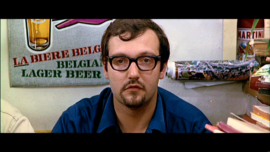
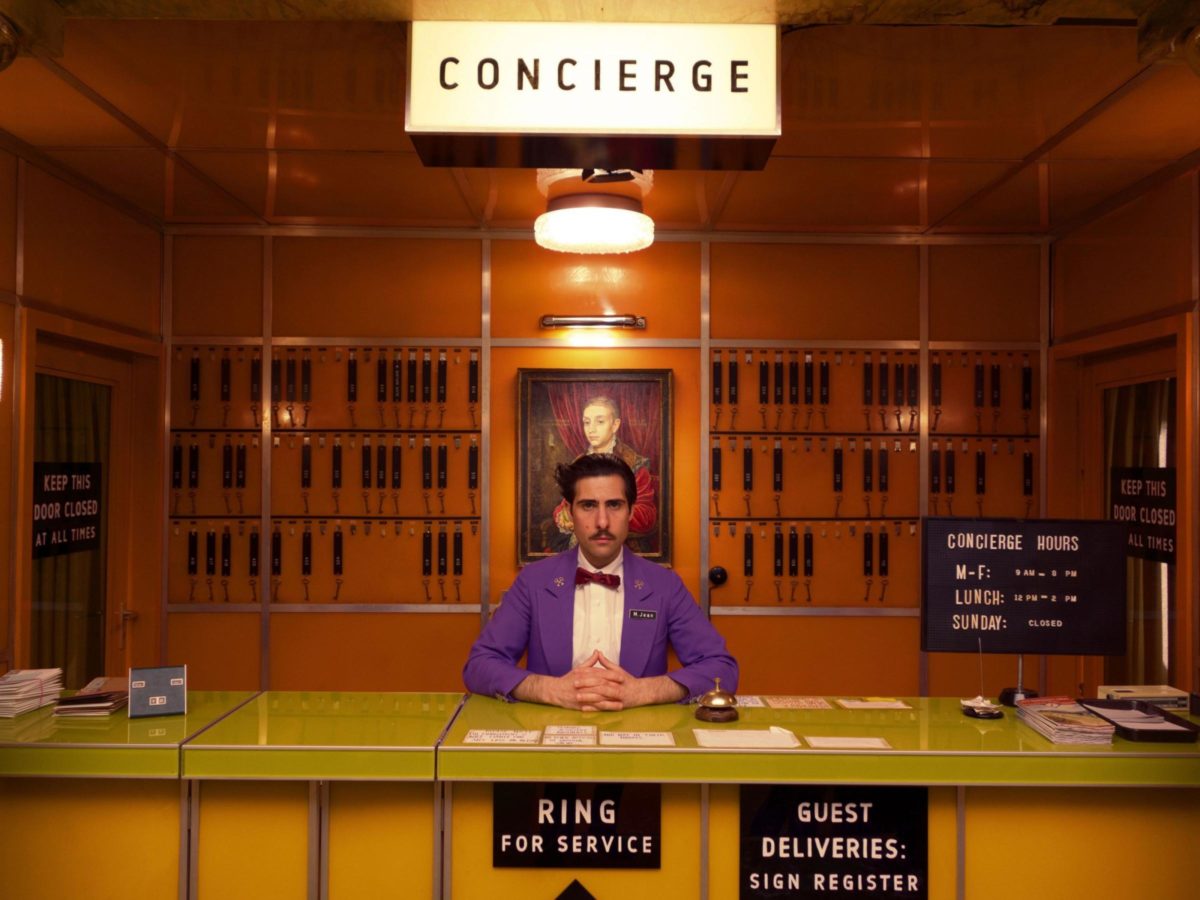
Both figures look straight at the camera as though posing for a picture or a photograph, or as though they are being interviewed or questioned. The result is a highly self-conscious composition with Brechtian leanings, which Anderson has probably done most to popularize in noughties independent cinema (Takeshi Kitano had earlier revitalized it during the nineties).
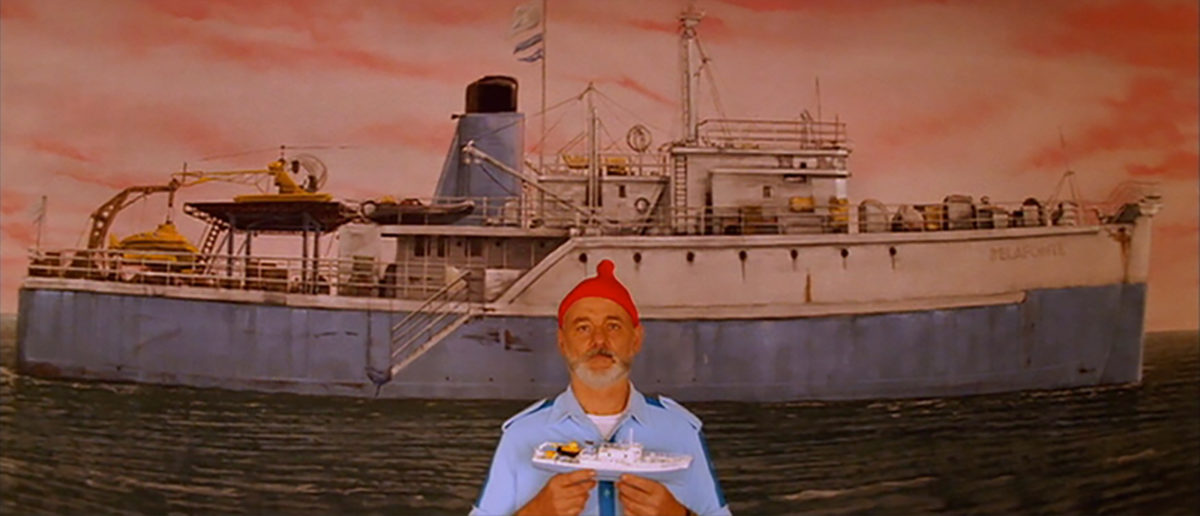
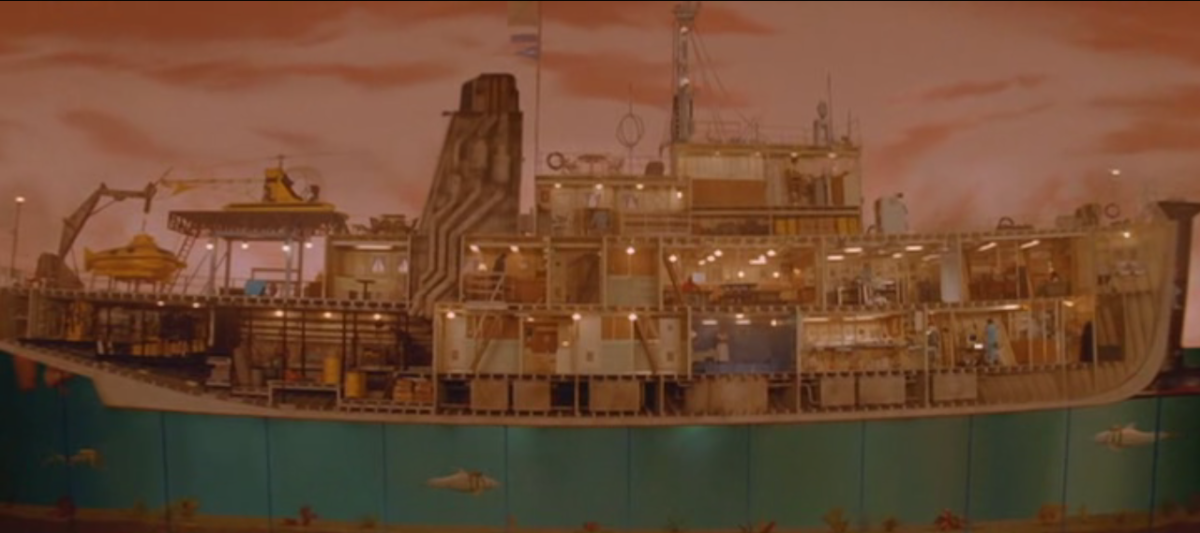
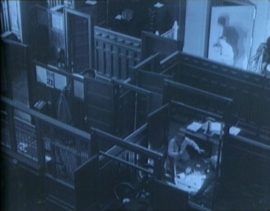
One of the great planimetric shots in The Life Aquatic, with which Grand Budapest shares several of its cast members, is a head-on view of Steve (Bill Murray) posing with a toy model of his boat against a perpendicular background of what appears to be a theatrical set drawing of the same boat, a World War II minesweeper called the Belafonte. ‘Let me tell you about my boat,’ Steve says, after which the background is raised to reveal a three-story high model of the Belafonte seen as a cross-sectional view cut open to reveal the spaces within in which we see the crew going about their business. Anderson cranes from one space to the next, exploring the boat like you would a dollhouse.
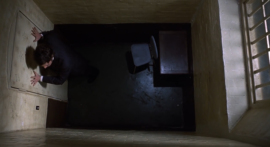
The idea of a cross-section or dollhouse-like set was first used by Maurice Tourneur in the opening scene of Alias Jimmy Valentine (1915), showing the multi-space interior of a bank from an oblique overhead angle. Fritz Lang then picked it up for The Spiders Part II and like most of Lang’s tricks it eventually ended up in Hitchcock, who used the dollhouse schema for Rear Window and the overhead shot for many of his films, like Frenzy.
Brian De Palma then went to work on it in films like Blow Out and Snake Eyes and, of course, anything De Palma does Tarantino borrows. Here are two frames, the first from Snake Eyes, the second from Kill Bill Vol. 1:
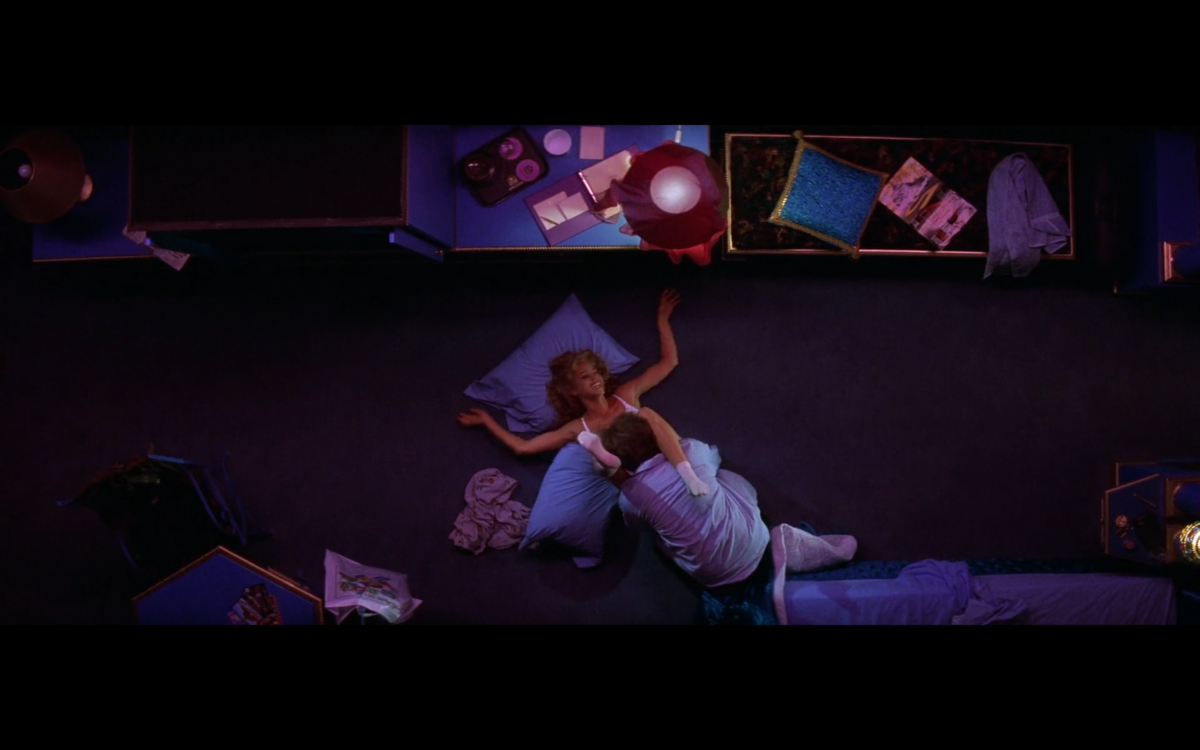
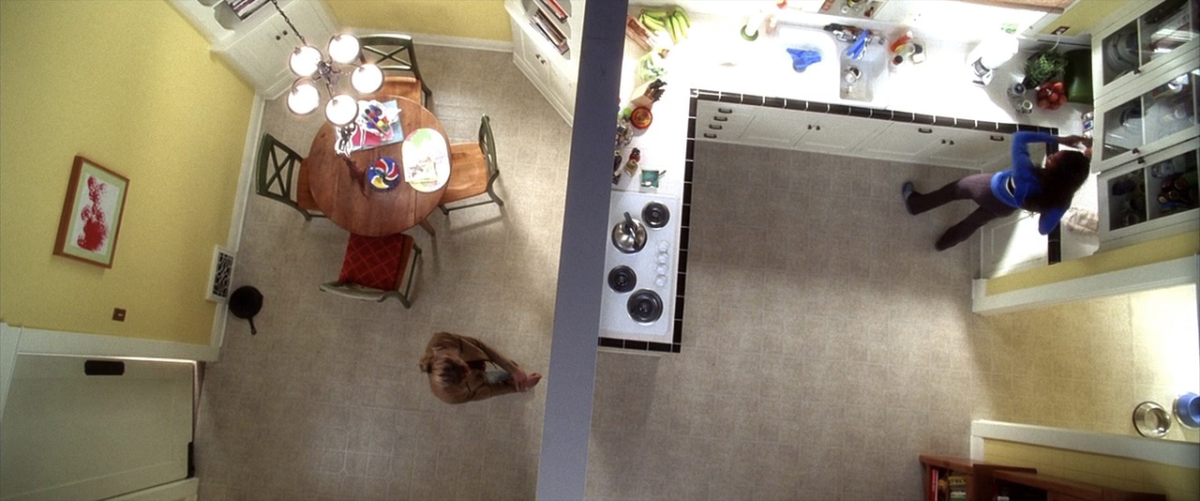
A variation on the dollhouse framing is the lateral tracking shot (a staple of the planimetric stylist) that moves along a series of cross-sectioned train compartments in The Darjeeling Limited, each containing a different (secondary) character in a different setting, from Natalie Portman as the ex-girlfriend to Bill Murray as the businessman.
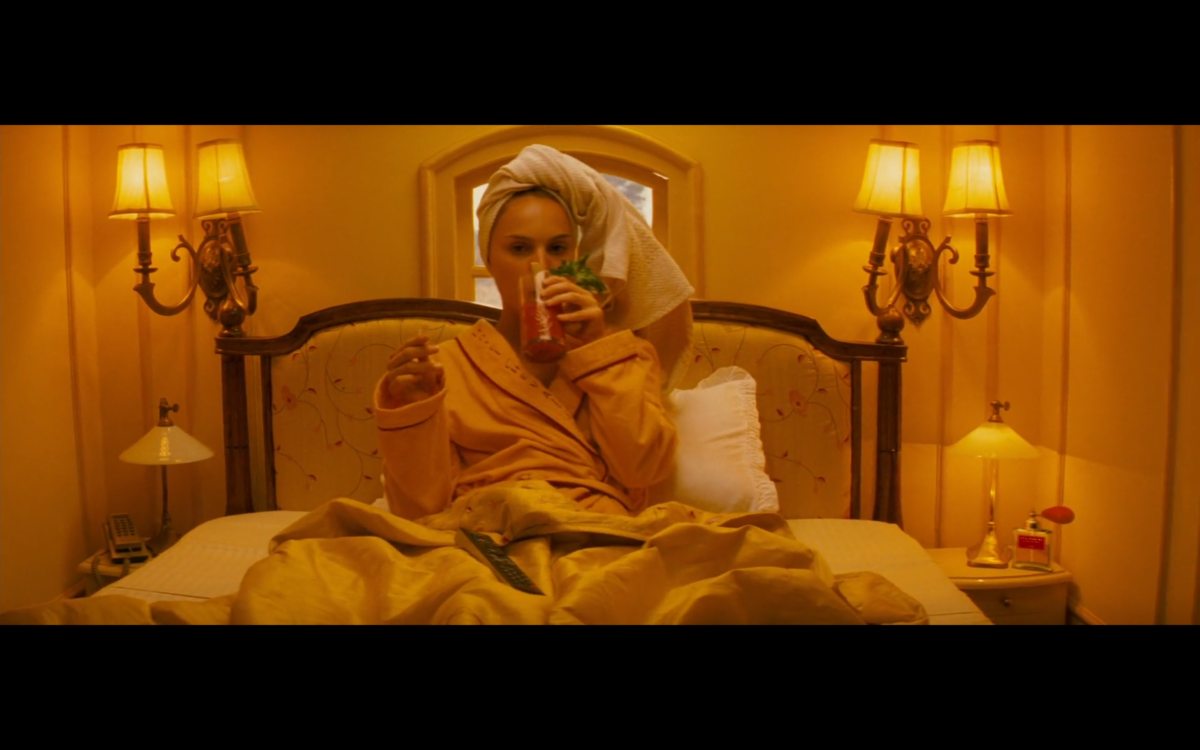
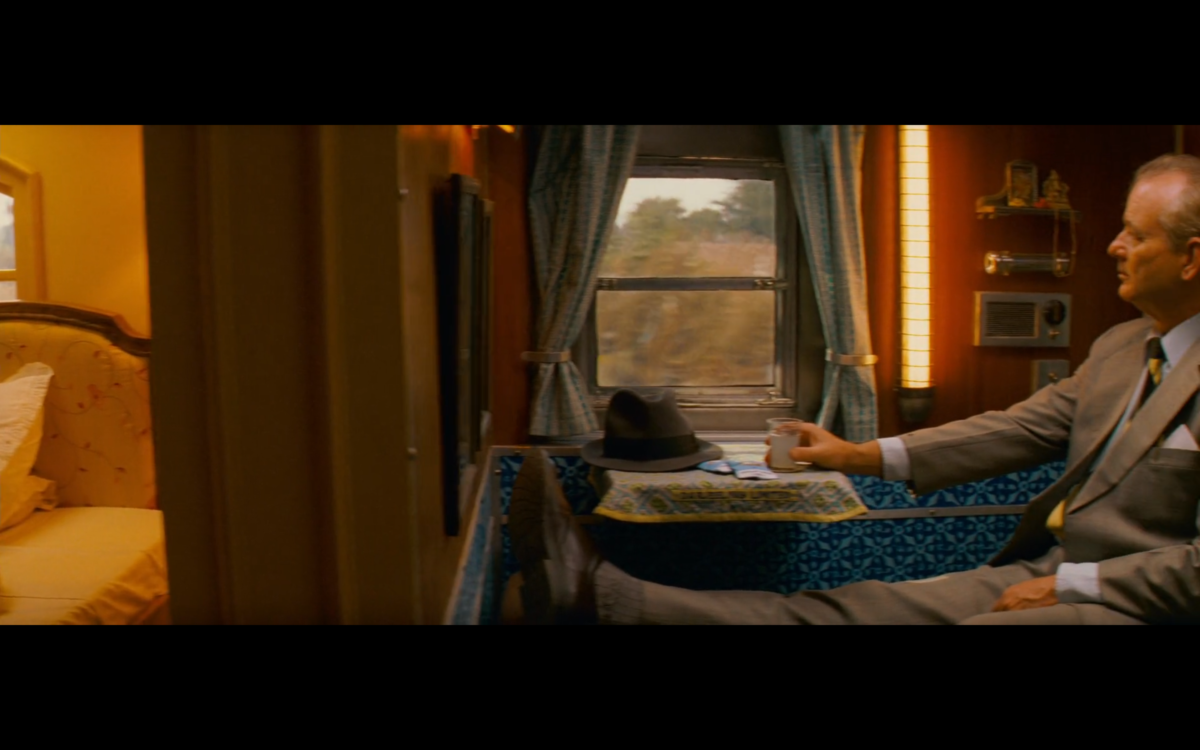
Anderson clearly loves trains, and one of the attractions of The Grand Budapest Hotel is the cable railway that travels to a miniature observatory. He also loves miniatures, which he feels create a handcrafted ‘old-fashioned brand of artificiality.’ The cable-car chase in Grand Budapest is straight out of Gaumont-British-period Hitchcock. The Lady Vanishes comes to mind, filmed in Shepherd’s Bush Lime Grove Studios, another movie set in 1930s Europe on the cusp of War in which the main characters are stopped at the border by nazties.
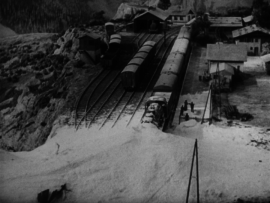
That movie famously starts with a sweeping panoramic shot over a miniature of the fictitious Alpine country of Bandrika that looks so blatantly fake that, especially given the prominence of wildly implausible sets in his later films and Hitch’s interest in and study of German Expressionist work with miniatures, it surely must be taken as an indication of the master’s delight in artifice. Hitch loved miniature trains as much as Anderson does, and they are seen in the station of Bandrika at the beginning of the sequence; they show up in Young and Innocent as well.
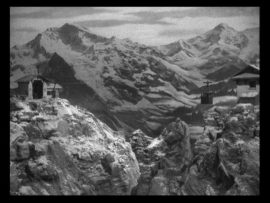
There are no mountain cable cars in The Lady Vanishes, but there are in another movie set in war-torn continental Europe, Carol Reed’s Night Train to Munich, a sort of ironic remake of The Lady Vanishes and misleadingly promoted upon its release as a sequel to the Hitchcock hit (mainly because it features the one-two act of the cricket-mad travelers Charters and Caldicott). In this film’s climactic scene, Rex Harrison’s British intelligence officer tries to get a Czech scientist’s daughter, Margaret Lockwood, across the border to Switzerland while pursued by Nazi soldiers. He puts her in the car with Charters and Caldicott while holding off the Nazis, then jumps on top of the next car, making it to safety. The sequence was filmed in the same Lime Grove studios and the ‘aerial tram’ looks as fake as the train set at the beginning of The Lady Vanishes, or the funicular railway in The Grand Budapest Hotel with its silhouette passengers.
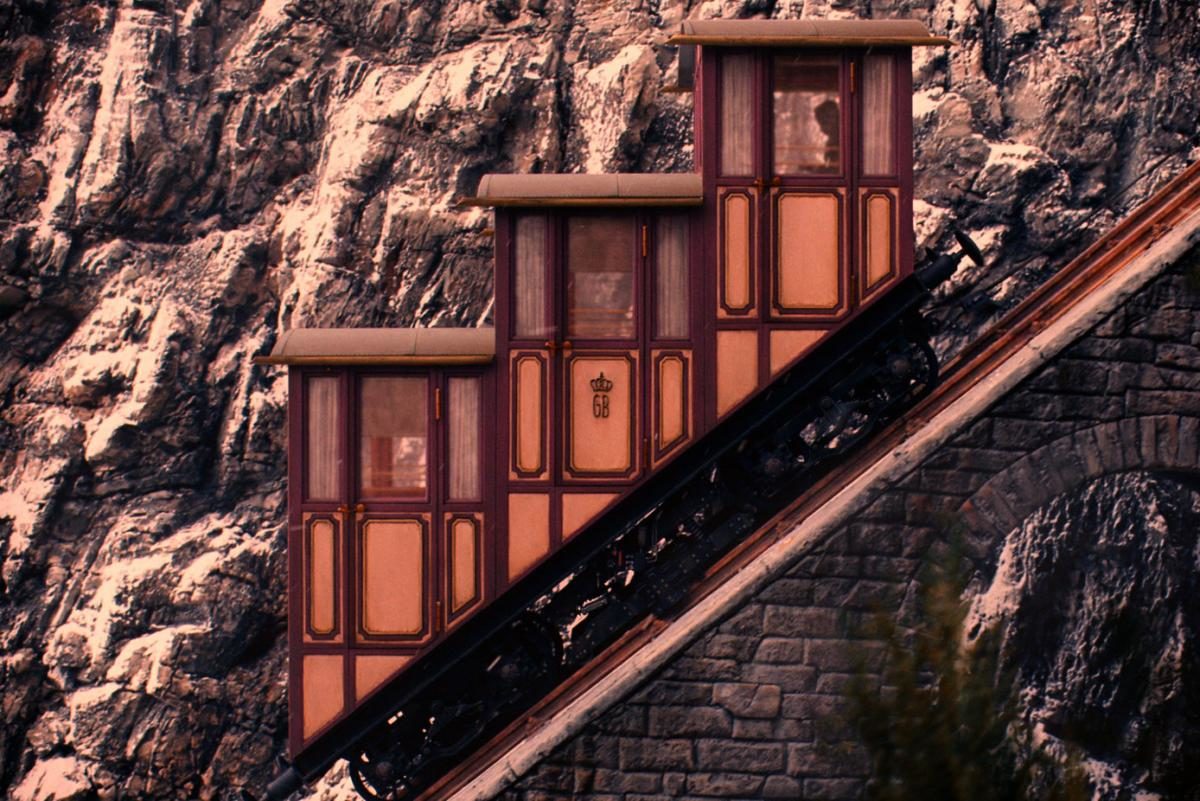
Talking about the influences on his film, Anderson has cited Disney’s One Hundred and One Dalmations for the ‘Twilight Bark’ that connects the members of the Society of the Crossed Keys, and there is the sense that the director is most at ease with the animated sequences in his films, with those most visibly ‘artificial’, like the joyous stop-motion downhill race. He also cites 30s Hitchcock as an influence and Torn Curtain(1966): ‘Anyone who knows the Hitchcock film will see that we’ve gone past homage and into the realms of plagiarism,’ he quips about Grand Budapest’s museum scene, that goofs off Hitchcock’s idea to highlight the resonating footsteps of Paul Newman’s pursuer by having Willem Dafoe’s leather-clad thug take off his shoes. Giselda Volodi, who plays Serge’s sister in Grand Budapest, is even made-up, costumed and framed to look just like Carolyn Conwell in Hitch’s movie. What Anderson takes from Hitchcock is the joy in artificiality, expressed through miniature work, backdrops, funny camera angles, garish colors and constructive editing techniques. Hitchcock was an aesthete, a dandy who modeled his persona after Oscar Wilde. In his book, Hitchcock and Romantic Irony, Richard Allen has firmly linked Hitchcock’s work to late nineteenth-century British decadentist culture. Even though he lacks the romantic irony that Allen attributes to Hitchcock, the mere fact that Anderson, like Hitch, strictly adheres to a carefully cultivated look and persona, confirms the aestheticist connection.
Aestheticism is often linked to camp and kitsch, and I think we need to ask whether or not Anderson’s work is either. About Hitchcock Susan Sontag (not a fan) says in her famous “Notes on Camp” that although forced and heavy-handed, films like To Catch a Thief, Rear Window, and North by Northwest, can never be camp because their ‘self-parody lacks ebullience’ instead revealing ‘a contempt’ for their themes and materials. I don’t think there’s self-parody in Anderson’s work, and he certainly fits the camp taste for theatricality, for the outdated (camp always holds a sentimental relation to the past), and for seeing everything in quotation marks. At the same time, his outlook is definitely more naïve, more honest and, why not, more ‘serious’ than Hitchcock’s. There is no contempt in Anderson for content or material, mostly because he is his own writer who deals with themes that are dear to him. At the same time, when he is adapting the material of others, the risk increases of, if not exactly contempt, but what David Thomson, in his severe review of The Grand Budapest, describes as ‘blindness’ and (unwitting) ‘complacency,’ making the work so much less than art and closer to kitsch or camp.
Where Hitch preferred to adapt genre writers like John Buchan, Francis Iles, Cornell Woolrich or Daphne Du Maurier, Anderson, for all his pop-cultural infatuations, has frequently flirted with high literary culture. The primary inspiration for Grand Budapest was Viennese novelist and playwright Stefan Zweig, specifically his novel Beware of Pity (Ungeduld des Herzens 1938),which he came across browsing in Paris’s American bookstore The Village Voice (another one of those fortuitous encounters). But although he borrows from Zweig the grand Alpine hotel, the Eastern-European castle of magnates, the impersonal single-letter names and the general theme of occupation and flight, Anderson is less interested in literary adaptation or exegesis per se than in using the writer’s work as a vehicle or structure for his own concerns. What he recognizes in Zweig is an aesthete’s nostalgia for finer culture, for a world when the barbarians were not yet at the gates. In Zweig’s case this is the world of the Viennese belle époque, the world of the Secession, the Wiener Werkstätte, but also of grand hotels, literary coffee houses and great patisseries. Although Anderson has been celebrated for conveying the nostalgic melancholy that is central to Zweig (Jonathan Romney in Film Comment: ‘This is a film about the past, the disappearance of societies and times, and the fragility of memory, all addressed within the context of the modern history of an imaginary European nation’), his nostalgia for the people, places, or things from a bygone era is not exactly Zweig’s, always and foremost historically situated, but what he recognizes in Zweig from what he has experienced through other books or films. Zweig’s work triggers a chain of allusions to movies set in the ‘old Europe’ of the Austro-Hungarian empire, primarily those by Lubitsch and Max Ophüls, who famously adapted Zweig’s novella Letter from an Unknown Woman (1948).
Zubrowka is a clear riff on Sylvania or Marshovia (or Hitchcock’s Brandrika), the fantasy European kingdoms of Lubitsch’s fairy tale musicals, ‘places of transcendence,’ in Rick Altman’s term, ‘where time stands still and contingent concerns are stripped away to reveal the essence of things.’ But at the same time it is a nostalgic place, like the turn-of-the-century Vienna of Letter from an Unknown Woman, where time weighs heavily and men and women of the world feel their world slipping away (as in The Magnificent Ambersons, a perennial touchstone for Anderson). It is this conception of the fin-de-siècle fairy tale that Anderson essays in his film, his first with an ‘international’ perspective. On the international aspect of Lubitsch’s cinema, Leo Braudy has said that the director’s ironic detachment is a strategy of cultural adjustment because irony ignores national boundaries and creates a truly international atmosphere. Anderson is an expat like Lubitsch who lives in Paris and shoots in landmark European studios like Cinecittà and Babelsberg, but whereas Lubitsch had to fit his style to the Hollywood system (which in turn learnt from him) Anderson has never worked outside that system. I’m pointing this out because I want to say that what I find missing in Anderson’s cinema, especially of late, is a sense of urgency. The idea of coming up with a contemporary variant of the fin-de-siècle fairy tale is ambitious enough, but then he upsets the precarious balance between Viennese sophistication and drawing-room wit on the one hand and his own child-like delight in trains, models and automata on the other by throwing in allusions – the tracking shots in the hotel corridors that echo Kubrick by way of Ophüls, Tilda Swinton as Madame de/D. – that push the multi-tiered confection over to the side of whimsy. Although you feel that Anderson’s is a unique blend of funny-sad (the comparison to Buster Keaton has never been more apt), the complex tone and mood changes don’t always work because there is really nothing much at stake. And the comedy is so funny that we might just as well enjoy the ride without having to worry about an almost forgotten Viennese author’s Jewishness or the double suicide at the end of his life.
The world that Anderson is lamenting through Gustave H., played by Ralph Fiennes as a cross between Zweig, Phileas Fogg, Herbert Marshall and Noel Coward, is of a second order. You really can’t expect the viewer to feel regret for the loss of something that was never real to begin with. In Film Comment Jonathan Romney turns this on its head by arguing that the film’s glittery emptiness is its whole point ‘because the “world of yesterday” (to use the title of Zweig’s memoir) has not merely vanished—it never really existed. It’s a gorgeous, fastidious reconstruction of a dream.’ This is creative reading against the grain, but really Anderson’s nostalgia has no relation to Zweig’s. If we feel the filmmaker’s nostalgia, it’s because we share his memories of the great films of olden days, including those made about Vienna at the turn of the century. So I would say that the feelings of nostalgia that Anderson manages to convey are closely tied to the condition David Bordwell calls ‘belatedness,’ a variant on Harold Bloom’s ‘anxiety of influence’ stripped of the psychoanalytic connotations, the idea that, after the great art of the past, it’s hard for today’s filmmakers to find a place that’s unique. ‘Belatedness’ expresses itself primarily through complete self-consciousness and constant allusionism, basing its forms ‘not so much on the particular object as on the art of the preceding epoch’ (according to the mode’s greatest historian, Arnold Hauser).
Anderson’s mannerism, I would say, has most negatively affected his storytelling skills. Everyone seems to agree that The Grand Budapest Hotel is a film about the nature of storytelling (Isabel Stevens in Sight and Sound: ‘It’s become a truism that each Anderson film is more in love with storytelling than the last’), sort of a contemporary One Thousand and One Nights. Like Sheherazade, Anderson is fond of telling stories within stories, using a frame story or introductory narrative to set the stage for a longer tale or a set of stories. The most important frame story in The Grand Budapest is that of Mr. Moustafa, the hotel owner, recounting to a young writer his adventures with Mr. Gustave in 1932. This is straight out of Zweig, whose Beware of Pity is framed by a nameless author telling his story. Zweig uses the device because he wants to create historical and emotional parallelism between the time of the framing story, the eve of the Second World War, and that of the embedded story, set on the eve of the First World War. That Anderson has no such intentions is indicated by the way attention is diverted from historical parallelism to formal play. Two further frames are added: the frame story with Mr. Moustafa set in 1968 is actually narrated by the older Author looking back in 1985 upon his youthful visit to The Grand Budapest, an act of narration that is in turn presented as the fantasy of a teenage girl who has come to visit the cemetery in Zubrowka to salute a monument to the national hero, Gustave H., the subject of the book she is carrying, The Grand Budapest Hotel. So where Zweig uses the framing story to convey historical irony, Anderson is more interested in playing a game of Chinese boxes or, more appropriately, Russian dolls, crafting the temporal equivalent of the scale-view shot of the universe. Anderson loves books, but sometimes he loves them like he loves his trains and dolls, as triggers for the imagination at play. His films often present themselves as contained in books: The Royal Tenenbaums is the title of a library book, Fantastic Mr. Fox presents itself as a book on the cover of which is written ‘based on the novel by Roald Dahl’. In the Paris Review, Kevin Nguyen offers that the reason why so manyAnderson films come with frame stories, ‘contained in books or recounted by storytellers at a far remove from the action,’ has to with the viewer understanding ‘that these are worlds Anderson has created, not attempts at realism.’ You could add: not attempts to get into the actual book (Fantastic Mr. Fox, Anderson’s single straight adaptation and his best film, is the exception).
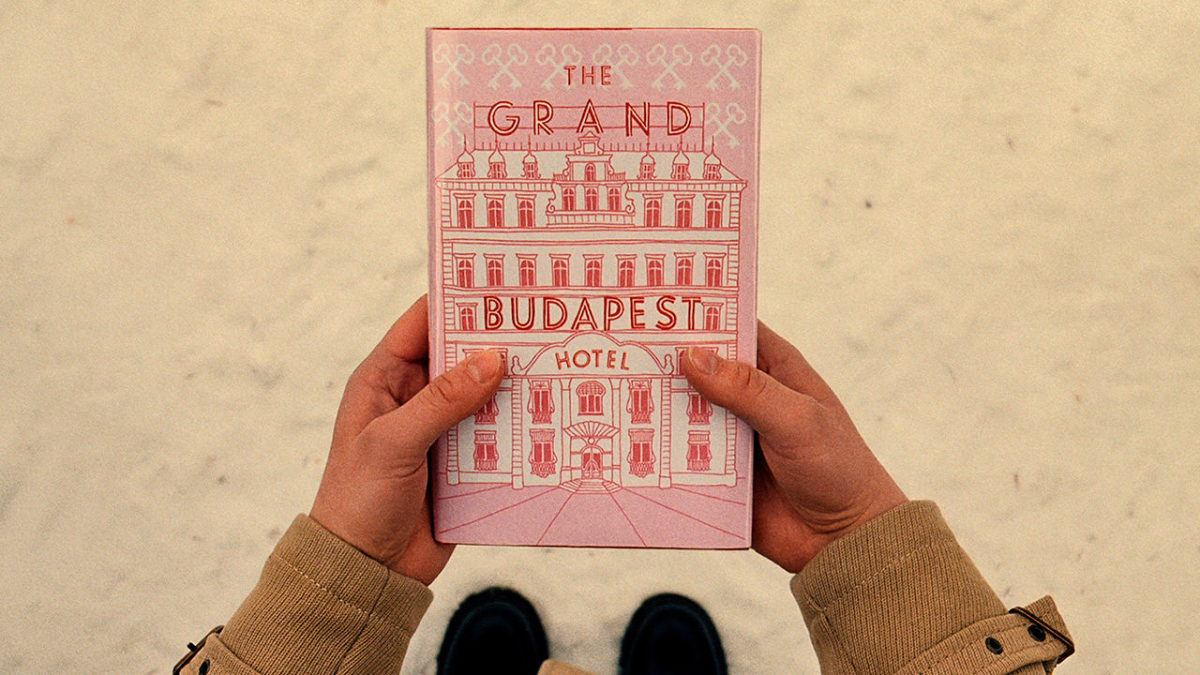
It used to be that one way to open your film was to show a hand opening a book and turning the pages. This device was mainly used in literary adaptations and storybook films, like Disney’s. Anderson seems to be thinking of this device in the opening of Grand Budapest, then overlaps it with the mode of narration that became de rigueur from the forties onwards: flashback narration. David Bordwell has explored how Hollywood increasingly started to experiment with embedded flashback structures and wacky narration during this period. But it wasn’t all about doing the wacky: to start your movie with a character’s memory which then leads into a flashback quickly became a staple of classical Hollywood narration. Perhaps the amplified treatment of the devices of both frame story and flashback must be seen as a parody in response to the recent criticism wedged at uninspired use of such frame stories in prestigious literary adaptations like The Curious Case of Benjamin Button, The Life of Pi and The Great Gatsby. But this can’t take away from the fact that the filmmaker seems to have forgotten the cardinal law of flashback narration: that we need to have a minimum degree of emotional investment in or identification with the character looking back on his life to achieve any degree of poignant sadness. You could argue that we do feel a certain amount of sympathy for Mr. Moustafa/Zero, the main character of the narrative core. But we have no investment whatsoever in the figure of the Author flashing back to the early days of his career. Max Ophüls’s adaptation of Zweig’s Letter from an Unknown Woman is a textbook case of tricky narration: in the movie, a woman’s downfall is narrated through recollections triggered by her letter to the man who is responsible for her ruin but who hardly remembers her at all, creating a complex play with subjectivity, identification and emotional engagement. Compare the Ophüls’s film to Grand Budapest, and you’ll learn the difference between tragic and comic irony.
But wait, you say, Anderson’s film is a comedy, and comedies generally don’t require much emotional engagement; they only require laughter, which comes about, as classical comedy theory has argued, through either a sense of incongruity, or feelings of relief or superiority. I’m not suggesting that Anderson should be making more ‘serious’ films, but then neither must his movies be treated as straightforward farces, screwballs or slapsticks. Although he often appears as a cross between Tex Avery, Buster Keaton and Howard Hawks, none of these filmmakers dedicated their movies to the memory of Stefan Zweig. David Thomson has called this dedication ‘startling’ and, finally, ‘distressing’: ‘So why is the name Zweig so startling at the end of The Grand Budapest Hotel? To put it simply, because this film is the work of a talented and vacant young director whose “brilliance” (I’m sure the word will be used) should not conceal his indifference to the depth of experience that preoccupied Zweig.’ (I’m pretty sure Thomson didn’t catch the director’s admission that ‘another key inspiration was Eichmann in Jerusalem by Hannah Arendt and her analysis of how the many occupied countries in Europe responded to the Nazis’ demands,’ which would have certainly added to his distress). Anderson is brilliant at screwball and slapstick which he puts to use for his peculiar brand of ‘quirky comedy’, a type of comedic address, James MacDowell has offered, that ‘requires we view the fiction as simultaneously absurd and moving, the characters pathetic and likeable, the world as manifestly artificial and believable.’ Comedic drama is the chosen mode of the filmmaker Anderson has probably emulated most closely, François Truffaut. But when Truffaut made his turn-of-the-century film, Les Deux Anglaises et le Continent, a film as deadpan, charming, episodic, melancholy and, yes, quirky as Wes Anderson’s best work, it was completely satisfying as a narrative. Perhaps the comparison is, yet again, unfair and we should be holding Anderson up to his contemporaries, like Christopher Nolan, who also knows a thing or two about Russian dolls or Chinese boxes. Anderson’s Boswell, Matt Zoller Seitz, for one is pretty ardent in his dismissal of (the critical response to) what he calls ‘puzzle movies’: “I feel like you’ve got to be careful that you don’t turn art into a puzzle. The worst example would probably be the films of Christopher Nolan. It’s gotten to the point where I can’t even read articles about Nolan, no matter how intelligent the writer is, because it’s like they’re decoding how to win a video game” (the entire interview is here). It’s fair to assume that Anderson knows nothing about videogames and, despite the embedded narration and the drawing-room mystery, there is no ‘puzzle’ aspect to his films. But neither does there seem to be much else to anchor or motivate narrative construction. There’s not even the simple pleasure on offer to be derived from clever chase narratives, exemplified by Hitchcock’s spy-adventure stories of the thirties, like The 39 Steps, from which, it is said, Hergé, another of Anderson’s inspirations, learnt quite a bit.In most of Bordwell’s noir examples, and in Nolan, the motivation of the embedded stories and framing stories is (Hitchcockian) suspense. There is no suspense in Grand Budapest, so the only thing we’re left with as motivation for the flashback structure is nostalgia, the lack of the audience’s emotional with which we’ve just argued is second-order.
The amplification of narrational technique that Bordwell finds typical of Mannerist cinema, is also flagged here by the decision to separate the different stories by varying the aspect ratios in which they were filmed: the story of the girl at the cemetery and that of the Author narrating his visit to the Grand Budapest were filmed flat and framed 1.85:1; the encounter between the younger Author and Mr. Moustafa was shot in anamorphic widescreen and framed in Anderson’s preferred 2.35:1; the story of Gustave and Zero was framed in 1.37:1 ‘Academy’ ratio.
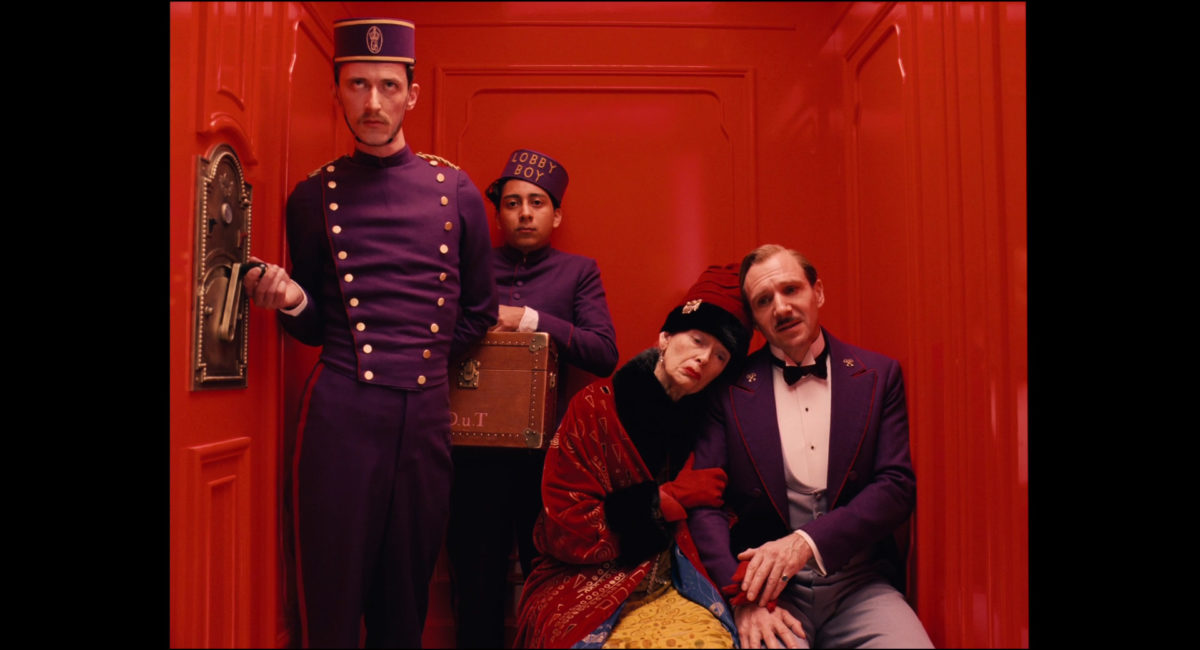
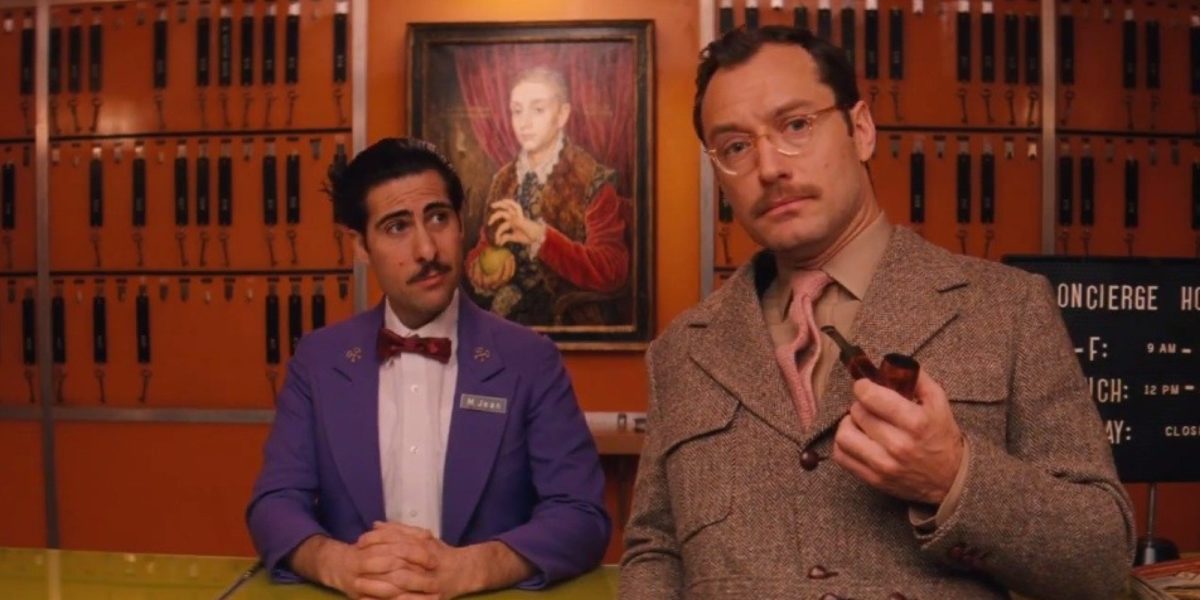
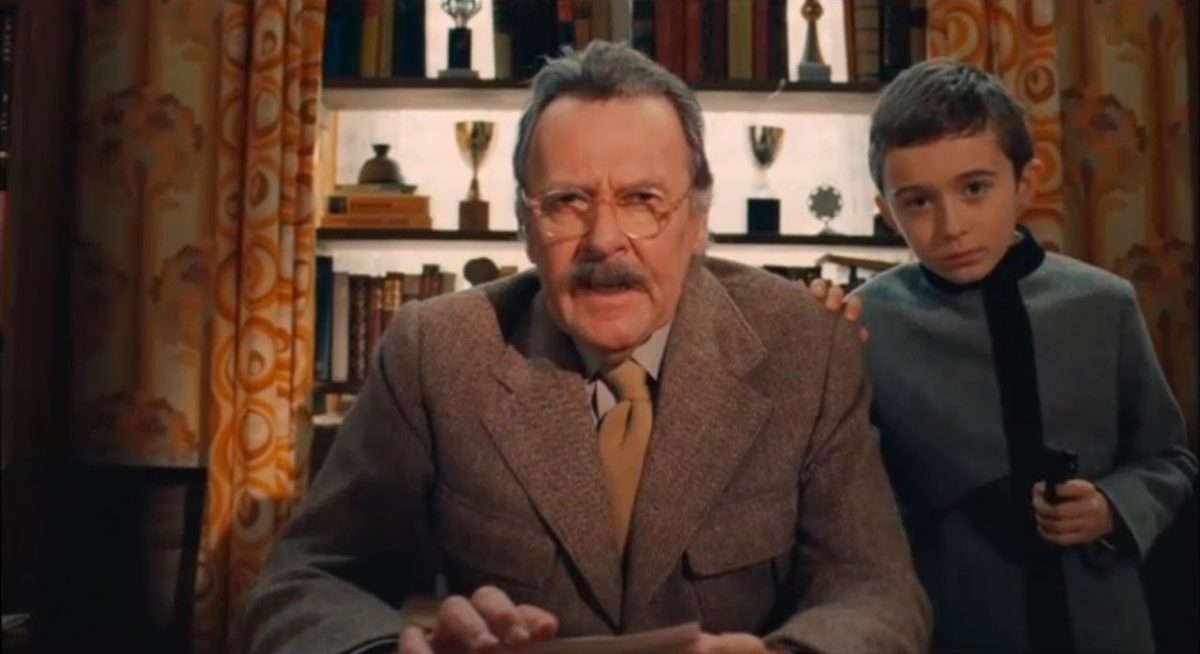
Like Scorsese separating the episodes of The Aviator by reproducing the look of two- and three-strip Technicolor, Anderson fits the framing to the historical period: the first two framing stories were shot in the aspect ratio that is most common today (the date of the second story even refers back to the format), while the flashback to the sixties was shot in the anamorphic format that was standardized during that period, and the original ‘Academy’ ratio fits the classical Hollywood style of Mr. Gustave’s day. Such turn to hyper-refined technique, unnoticeable to most audiences, to distinguish what are, in most cases, easily distinguishable narrative layers, is familiar from films like Hero and Requiem for a Dream (color-coordinating their different episodes), or Traffic and Babel (distinguishing story threads through texture, grain, film gauge and various uses of lab processing). Grand Budapest shares its play with different aspect ratios with Babel. According to Bordwell, one of the primary lessons to be drawn from that movie is that ‘those who think that modern Hollywood has entered a mannerist phase can find confirmation in Babel.’ I think they’ll find further proof in The Grand Budapest Hotel.